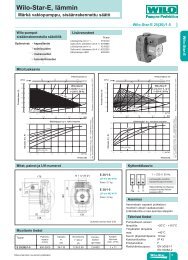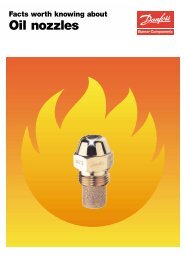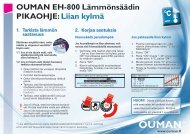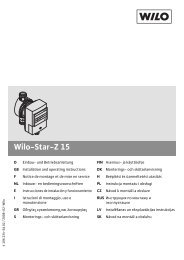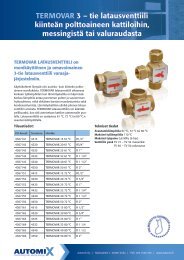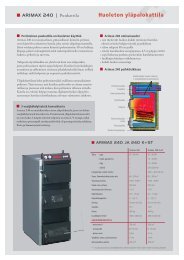Practical tips - Danfoss Heating
Practical tips - Danfoss Heating
Practical tips - Danfoss Heating
- No tags were found...
Create successful ePaper yourself
Turn your PDF publications into a flip-book with our unique Google optimized e-Paper software.
making modern living possible<strong>Practical</strong> <strong>tips</strong>Oil nozzlesDANFOSSBURNER ComponenTS
Dear <strong>Danfoss</strong>partnerDear <strong>Danfoss</strong> partnerAs one of the most important oil nozzle manufacturers<strong>Danfoss</strong> wants with this booklet to be ofassistance to you in your daily work.With this booklet you can choose and fit <strong>Danfoss</strong> oilnozzles for all purposes and for any demand.In addition to that you get valuable <strong>tips</strong> and referencesto how to fit oil nozzles in your working area.How important the function of the oil nozzle is tothe oil burner appears clearly from this booklet.<strong>Danfoss</strong> assists you in handling these mechanicallycomplicated products which are of vital importancefor the function and the output of the oil nozzle.For further help in your work with oil burner components<strong>Danfoss</strong> refers to our Service handbookabout burner components and to our homepageburner.danfoss.com
<strong>Practical</strong> <strong>tips</strong> about<strong>Danfoss</strong> oil nozzlesTable of contents:PageThe oil nozzle and the complete oilheating plant.............................................................. 3What you should know at least aboutoil nozzles................................................................... 4How does an oil nozzle work?................................. 5Spray patterns and spray angles of the oil nozzle.. 6Marking of the oil nozzle......................................... 7How is the correct oil nozzle chosen?.................... 8Boiler capacity and nozzle sizing............................ 9Calculation of oil nozzle capacity........................... 10Is it possible to compare oil nozzles of differentmakes?........................................................................ 11Conversion table for oil nozzles.............................. 12For how long can an oil nozzle be used?................ 13What effects the function of the oil nozzle?.......... 14Tips about replacement of the oil nozzle............... 15What effect have dirt and sediments in fuel oil?... 16What causes an oil nozzle to drip?.......................... 17What causes an afterdrip of oil when the burnerstops?.......................................................................... 18
<strong>Practical</strong> <strong>tips</strong> about<strong>Danfoss</strong> oil nozzlesTable of contents:What causes the oil to coke on the oil nozzle and theignition electrodes?................................................... 19What is the cause of no oil from the oil nozzle?... 20What to do with the old oil nozzles?...................... 21What matters are the details............................. 22, 23
The oil nozzle andthe complete oilheating plantA complete oil heating plant begins at the oil tankfilling connection and ends at flue or the chimneypipe.Almost at the heart of the plant, hidden from alleyes, is a small interesting gadget – the oil nozzle.The oil nozzle plays a vital role in combustion,because it would be absolutely impossible to getCLEAN, STABLE and ECONOMIC plant operationif it is not handled correctly.The oil nozzle should be treated like a dear friend,i.e. protectively and considerately. Be careful neverto touch the tip of the nozzle and the nozzle orificewith dirty fingers, as this might cause the nozzleorifice to clog. To pick up the nozzle, always grip thespanner flats only.Storing:Always leave the nozzle in its protective coveringuntil it is to be installed in the burner.Transport:Always use the <strong>Danfoss</strong> nozzle casefor transport; the nozzle willbe well-protected in this way.
What you shouldknow at leastabout oil nozzlesThe oil nozzle is of vital importance to the combustion.It is only possible to get at clean, stable and economicalplant operation when the oil nozzle functions toperfection.The best result is obtained when the oil nozzle isreplaced once a yearThe reason is that in the course of the heating season,dirt particles gather in the nozzle filter and in the oilnozzles and ruin or hinder a perfect atomizing.Both the environment and the oil account will profitfrom a perfect oil atomizing. Further service visitsdue to clogged oil nozzles should not be necessary.<strong>Danfoss</strong> oil nozzles are extremely precise andmeet the requirements of the actual EN-norm of acapacity tolerance of ±4%Nozzles produced by <strong>Danfoss</strong> are tested 100% in testoil for keeping the tolerances permitted. Beyond this,the atomizing patterns are tested visually for regularityand atomizing faults, if any.Has a new <strong>Danfoss</strong> oil nozzlebeen installed?
The function of theoil nozzleFig. 1 shows the way the fuel oil runs through the oilnozzle: The fuel oil is put under pressure by the oilpump and runs into the oil nozzle and is filtered inthe nozzle filter. In the swirl chamber the fuel oil“rotates” and leaves the oil nozzle for being burst inmany fine small drops. The orifice and the cone slotsdetermine the spray characteristics.Fig. 1: The way the fuel oil travels through the oil nozzleBurners used today, designed exactly to the heat requirementof the house, have resulted in a reductionof the burner capacities. So the cross section in theoil nozzle had to be reduced, too.The orifice diameter on an oil nozzle is thus only afew tenths of a millimetre (fig. 2 ), which means thatnon-professional treatment may cause immediateoperational problems.Fig. 2: Nozzle orifice compared with ahair from a human being
Spray patterns andspray angles of oilnozzlesThe properties of the oil nozzle appear on the nozzlemarkings. Oil nozzles are available with differentspray patterns and spray angles. These must fit theburner in question and of course also the combustionchamber of the boiler.The designations of the spray patterns on <strong>Danfoss</strong> oilnozzles are S (Solid); H (Hollow) and B (Universal =semi solid). Other marks have similar designations.Fig. 3: Spray patterns of the oil nozzleFrom left to right: Spray patterns B, S and H.The sizes of the spray angles are normally 30°, 45°,60° and 80°.Fig. 4: Spray angles 30°, 45°, 60° and 80°
Marking of the oilnozzleFrom the marking on the <strong>Danfoss</strong> oil nozzles it is easyto read the capacity, spray pattern and spray angle.Some types also provide information on norm specificproperties according to the norm in question, e.g.EN 293 and 299.Some countries have specific demands on definitionpoint (e.g. England, Japan or the USA).Marking on an oil nozzle, type OD with a capacity of2.37 kg/h 2)• EN states that the oil nozzle is in accordance withthe norms EN 293 and EN 299.• 80° II states the characteristic of the oil nozzle, i.e.angle index and atomizing index according to ENNorm 2) .• The figures in the square brackets [ ] are an internalseries code.• The USgal/h value states the oil nozzle capacityin another definition point 1) , which formerly wasspread globally in the industry – and is still usedin especially the customer area. To be able to meetthe demands in this market, these designationswill be maintained on all <strong>Danfoss</strong> oil nozzles.1) Definition point USgal/h = 7 bar, 3.4 mm²/s, 820 kg/m³2) Definition point kg/h according to EN 293 = 10 bar, 3.4 mm²/s, 840 kg/m³
Boiler capacity andnozzle sizeThe capacity of a boiler is normally stated either askcal/h or as kWa) kcal/h = kilo calorie per hourAs each kilogram of fuel oil at combustion yields10,000 kcal = 10 Mcal, it is easy to calculate whatnozzle size to choose.Example:For a boiler stamped 25,000 kcal/h, choose an oilnozzle of 2.5 kg/h at a pump pressure of 10 bar.(25,000 : 10,000 = 2.5 kg). This unit capacity wasalso introduced in the nozzle standard.b) kW = kilowattThe designation kW will be used more frequentlyin future, as the unit forms part of the SI-system ofmeasurements.1 litre of fuel oil yields at combustion approx. 10 kW.It is therefore easy to choose the right size of a <strong>Danfoss</strong>oil nozzle for a boiler if the capacity is stated in kW.As <strong>Danfoss</strong> oil nozzles are marked with kg/h, a conversionmust be made.1 litre of fuel oil = 0.84 kg, e.g. 20 kW boiler capacity= 2 litres or 1.68 kg/h at a pump pressure of 10 bar.The examples overleaf show how simple it is to calculatethe nozzle sizes for a different pressure.
Calculatingexamples forchoice ofoil nozzlesExample 1:Here we want the required pressure setting with anoil nozzle of 2.11 kg/h to obtain a flow rate of 2.5kg/h.V2 = 2.5 kg wanted flow rateV1 = 2.11 kg/h nozzle capacity at 10 barP1 = pump pressure at 10 barP2 = the wanted pump pressureV2 = V1 × √ P2:P1 ; P2 = V2²: V1² × P1 ;P2 = 2,5² : 2,11² × 10 = 14 barPressure setting with an oil nozzle of 2.11 kg/h mustbe 14 bar to obtain a flow rate of 2.5 kg/h.Example 2:Here we want the flow rate of an oil nozzle of 2.11 kg/hat a pump pressure of 12 bar.V2 = wanted flow rateV1 = 2.11 kg/h flow rate at 10 barP2 = pump pressure at 12 barP1 = pump pressure at 10 barV2 = V1 × √ P2:P1 = 2,11 × √ P2:P1 = 2,31 kg/hAt a pump pressure of 12 bar it is possible to obtaina flow rate of 2.31 kg/h with an oil nozzle of a capacityof 2.11 kg/h.A further help for quick determination of a suitable oilnozzle is the nozzle calculator or the nozzle capacitytable.<strong>Danfoss</strong> has thus placed a nozzle calculator on theinternet, with which the right oil nozzle can be foundquickly (see burner.danfoss.com).10
Is it possibleto compareoil nozzles ofdifferent makes?The situation may arise where a nozzle of anothermake is to be replaced by a <strong>Danfoss</strong> oil nozzle andthe question arises how to compare the differentmakes. The instruction book of the oil heating plantoften contains advice and gives information on thedifferent makes and types to use. Capacities givenfor the different nozzle types can be directly compared.Spray angles too can be compared as the sizeof the angle is stamped on the oil nozzle.11
Conversion tablefor oil nozzles<strong>Danfoss</strong> oil nozzles types H, S, HR, SR and B canreplace the following oil nozzles of other makes:Conversion to <strong>Danfoss</strong> oil nozzles1. First choiceof oil nozzle2. AlternativeproposalDelavan A <strong>Danfoss</strong> H <strong>Danfoss</strong> HRDelavan B <strong>Danfoss</strong> S <strong>Danfoss</strong> SRDelavan W <strong>Danfoss</strong> B –Fluidics SF <strong>Danfoss</strong> SR <strong>Danfoss</strong> SFluidics HF <strong>Danfoss</strong> HR <strong>Danfoss</strong> HFluidics S <strong>Danfoss</strong> SR <strong>Danfoss</strong> SFluidics H <strong>Danfoss</strong> HR <strong>Danfoss</strong> HMonarch PL <strong>Danfoss</strong> HR <strong>Danfoss</strong> H/BMonarch NS <strong>Danfoss</strong> HR <strong>Danfoss</strong> HMonarch PLP <strong>Danfoss</strong> B –Monarch AR <strong>Danfoss</strong> SR <strong>Danfoss</strong> SMonarch R <strong>Danfoss</strong> SR <strong>Danfoss</strong> SHago B <strong>Danfoss</strong> SR <strong>Danfoss</strong> SHago H <strong>Danfoss</strong> HR <strong>Danfoss</strong> HHago SS <strong>Danfoss</strong> HR <strong>Danfoss</strong> H/BHago P <strong>Danfoss</strong> SR <strong>Danfoss</strong> SHago ES <strong>Danfoss</strong> SR <strong>Danfoss</strong> SSteinen PH <strong>Danfoss</strong> HR <strong>Danfoss</strong> H/BSteinen H, HAT <strong>Danfoss</strong> HR <strong>Danfoss</strong> HSteinen SS <strong>Danfoss</strong> B –Steinen Q <strong>Danfoss</strong> SR <strong>Danfoss</strong> SSteinen S, ST <strong>Danfoss</strong> SR <strong>Danfoss</strong> SThe stated values are based on experience and are thus only to be considered as a guideline. Whenreplacing oil nozzles, first and foremost use oil nozzles with the same shape of head.12
For how long canan oil nozzlebe used?An oil nozzle can be used for as long as a reasonablecarbon dioxide percentage (CO 2%) and a suitablylow soot count can be maintained. Whether the life ofan oil nozzle will be 1 year or more is hard to predict,as it depends very much on how many hours the planthas been operating and how clean the oil is and thecondition of the tank.The life of an oil nozzle is shortened considerably if,say, nozzle filter and pump filter, if any, are missingor these parts are defective or dirty. If the oil nozzleis exposed to strong radiant heat from, say, heavilyglowing incombustible material, the life will beshortened too, as the strong heat may cause the oil tocoke and collect around the nozzle.13
What can disturbthe function of theoil nozzle?In connection with service visits the question is oftenasked what has caused the oil nozzle to fail? We willhere try to describe some of the most frequent faultsand how they can be rectified.Setting of the burnerThe most frequent fault is probably wrong setting ofthe burner. The values stated by the burner manufacturermust be observed, such as pump pressure, adjustmentof ignition electrodes, etc. It is especiallyimportant that the adjustment of the two ignitionelectrodes is strictly accurate (fig. 5 and fig. 6). It isof frequent occurrence that the ignition electrodesare not adjusted correctly and the ignition goes froman electrode to the oil nozzle. This is clearly seenfrom burned spots or from advanced grooves in theoil nozzle. Nowadays the location of the oil nozzle inrelation to the baffle plate is often optimized withfirm impact rims in the burner. The right spray angleis also very important, both to prevent the oil fromthe oil nozzle spraying against the baffle plate and toprevent the mixture proportion between air and oilmist to change because of a too small spray angle.14Fig. 5 and fig. 6:Examples on distance between electrodes
Tips for change ofthe oil nozzleThe right way to change an oil nozzleWhen changing an oil nozzle, it is especially importantthat the nozzle holder is bled well and the oilpassages are cleaned. After demounting of the oldoil nozzle in a horizontal position (pos. 1), the nozzleholder is cleaned with a clean, flockfree cloth.Then the burner is placed in service position (pos. 2)and in this position, vertically upwards, the nozzleholder is filled to the rim with fuel oil.Pos.1 Pos. 2Now the new oil nozzle is slowly screwed in so thatthe air in the oil nozzle can be let out. After the newoil nozzle has been inserted, the nozzle plate shouldnot be touched with the fingers any more to preventdirt in the nozzle orifices.By doing so, it is prevented that dirt loosened duringdemounting of the oil nozzle stays in the nozzleholder and later causes the nozzle to fail. Never useaggression when mounting the nozzle as this canruin the sealing surface between the oil nozzle andthe nozzle holder.Suction torque for oil nozzlesRecommended suction torque15-20 NmMaximum suction torque25 Nm15
What effect havedirt and sedimentsin fuel oil?Dirt/sediments in fuel oilThe oil nozzle is equipped with different filters, dependenton the size of the nozzle. These nozzle filtersare normally always sintered bronze filters in thelowest capacity area and have very good properties,especially where rod-shaped and thready dirt praticlesare concerned.When such particles have reached the interior of thenozzle, they will soon ruin the nozzle (fig. 7).Therefore, the right choice of prefilter is of decisiveimportance for the life of the oil nozzle(fig. 8).Fig. 7: Dirt sediments in the swirl chamberRuined/dirty – newFig. 8: Ruined cartridge filterNowadays cartridge filters of different fineness andsizes are available. Thus the fineness for normal useare ranging from 100 µ over 50-75 µ to 25-40 µ. Butalso cartridges with finenesses of 5 µ are offered. Afiner pre-filter is always to be preferred to a coarsepre-filter. Measure the pressure drop regularly! A toohigh value indicates a choked filter.16
What causes an oilnozzle to drip?In fairness it has been maintained from the beginningthat in most cases the oil nozzle is not the cause ofafter dripping. But whatever the cause may be, afterdripping from the oil nozzle must in any circumstancesbe stopped as quickly as possible to prevent soothingup of the burner head or the area around it or thecombustion chamber.Oil drips when the burner startsThis can happen during preheating in the oil preheaterwhen the oil expands or during prepurge due to adirty or defective closing valve in the oil pump.Oil is dripping during operation• The oil nozzle is located too far from the baffleplate or the burner head.• Igniton electrodes protrude into the oil mist, sothey are placed incorrectly.• Dirt in the oil nozzle or oil coke in and on thenozzle orifice.• The nozzle orifice is defective, because of attemptsto clean it.• Too low oil pressure. Remember to check nowand then.17
What causes afterdripof oil when theburner stops?Afterdrip of oil when the burner stopsWhen the burner stops and the oil nozzle sprays ajet of oil instead of cutting off the oil supply withlightening rapidity, the most likely reasons are:A slight leak in the suction line may result in tinyamounts of air getting into the oil pump, the pressureline or the oil nozzle.Such an amount of air is, however, not sufficient todisturb the function of the burner, but large enoughto produce an afterdrip and even an oil jet when theburner stops. This will eventually lead to the partsgetting dirty and cause malfunction.The oil in the oil pressure line between the pumpand the oil nozzle contains air.Even with a perfectly operating closing valve anda thorough bleeding of the pressure lines, afterdripof oil can be seen because of the radiation of heatfrom the combustion chamber, which expands theoil and forces it into the oil nozzle after the burnerhas stopped.18
What causesoil coke on theoil nozzle andignition electrodes?When liquid oil is heated above a certain temperaturea process takes place called “cracking” and a stonehardblack carbon settles. Under normal operatingcondition, the amount of carbon deposited on thenozzle and ignition electrodes will be unnoticeable.But just a slight scratch on the tip of the nozzle cancreate a path along which small amounts of oil canfind their way. This oil is exposed to a very strong radiantheat and will, consequently, produce carbon onthe tip of the nozzle and cause interference with theamomizing process and can cause poorer combustion.The same thing happens when the oil nozzledrips.If the ignition electrodes are placed incorrectly, so thatthey can be hit by the injected oil, the heat from theflame will in time start carbon deposits to build up onthe tip of the electrodes. Eventually, the electrodeswill short circuit and there will be no ignition sparkand plant restart will be impossible. Coke formationon oil nozzle and ignition electrodes will inevitablylead to operating problems and poor combustionand must at all costs be avoided.19
What is the causeof no oil from thenozzle?To say the least, it is irritating if not one drop of oilemerges from the nozzle. To eliminate the problem,follow the rules below for “immediate help” step bystep.• Is there oil in the tank?• Is the valve on the suction line open or closed?• Is the check-valve on the suction line the wrongway round?• Does the pump shaft rotate?• Is the connection between pump and motor ok?• Can any suction effect of the pump be seen?• How much vacuum does the vacuum metershow?• Can the presence of air be seen in one of thetransparent test hoses on the suction side of thepump?The reason may be a too high vacuum or a leakysuction line.• Is the pump filter clean and in good order?• Are the valves (the hydraulic valve or the solenoidvalve of the pump) open and working properly?• Is there dirt in the oil pressure line to the oil nozzle?• Is the nozzle filter clean and in good order?• Is the oil nozzle blocked?• Is the oil very cold and thick?Perhaps some water in the oil has turned into ice.If all these factors arechecked and ordered asnecessary, the oil nozzleshould spray oil.20
What to do withthe oil nozzle?Waste and re-use are topical subjects at the momentand though there are many things which can be usedagain and again, it cannot be expected that an oldand dirty oil nozzle will be of use to anybody. So reuseof an oil nozzle must therefore be depreciated.For safety’s sake, old oil nozzles must be thrownaway immediately.21
What matters are the detailsThe simple appearance of the oil nozzle throws its complicated mechanisminto the shade.The narrow tolerances of the oil nozzle and the fine details play a decisiverole for function and performance.Accurate toolsAccuracy is the key to an optimumfunction. So does the production demandthe highest precision. <strong>Danfoss</strong>takes many measures to ensure thequality. These also include productionof embossing arbors which are grindedwith tolerances of only a few µm. Thisensures the form in the inlet and theoutlet of the nozzle.Maximum repititionThe fine cone slots are cut with a realdiamond to ensure highest precisionand the best surface. The precisemanufacture of the nozzle plate andmeasurements with the paternator ensuremaximum repetition of spray pattern,spray angle and performance.
Compliance with the stricteststandards<strong>Danfoss</strong> oil nozzles are second to nonewhen compliance with internationalnorms and standards are concerned.This appears from the list below:• First manufacturer of the EN-oilnozzle (1992)• First oil nozzle manufacturerwho met the requirements of theOFTEC-standards (1995)• The oil nozzles have been approvedaccording to CSA-standard<strong>Danfoss</strong> has also been ISO-9001certified and our production plantsmeet the environmental authorities’conditions in ISO 14001.
<strong>Danfoss</strong> ist der führende Hersteller für Komponenten für<strong>Danfoss</strong> is a leading global manufacturer of componentsbrennbare Flüssigkeiten, die in Haushalt, Gewerbe undfor combustible liquid burners used in domestic, commercialIndustrie verwendet werden. Diese Position wurde erreichtand industrial applications. This position has been achievedindem die Erwartungen der Kunden übertroffen wurde;by exceeding the expectations of our customers; respondingschnelles eingehen auf die gestellten Anforderungen;quickly to their requirements; providing high quality in allLieferung von hoher Qualität und wettbewerbsfähigerespects and offering competitive prices – all with due considerationfor the environment.Preise – alles unter Berücksichtigung der Umwelt.Unser Produktbereich für Brenner und Kessel umfasst:Our product range for oil burners and boilers comprises: oilÖlpumpen, Öldüsen, Ölvorwärmer, Zündeinheiten,pumps, oil nozzles, preheaters, ignition units, burner controlsÖlfeuerungsautomaten und Thermostate.and thermostats.DasTheHerzHeartderofHeizung<strong>Heating</strong>520F0666 <strong>Danfoss</strong> can DKBD.PB.060.B1.03accept no responsibility for possible errors in catalogues, brochures brenner.danfoss.com and other printed material. <strong>Danfoss</strong> Produced reserves by <strong>Danfoss</strong> the right A/S to © alter Industry its products Service – G1 without Advertising notice. 06.09 This also applies to520F0655 products already DKBD.PB.060.B1.02 on order provided that such alterations can be made without subsequential burner.danfoss.com changes being necessary Produced in specifications by <strong>Danfoss</strong> A/S already © Industry agreed. Service – G1 Advertising 06.09All trademarks in this material are property of the respective companies. <strong>Danfoss</strong> and the <strong>Danfoss</strong> logotype are trademarks of <strong>Danfoss</strong> A/S. All rights reserved.520F0638 DKBD.PS.060.A2.02 burner.danfoss.com<strong>Danfoss</strong> A/S © - G1 Advertising 07.01 FO/bpv ro



